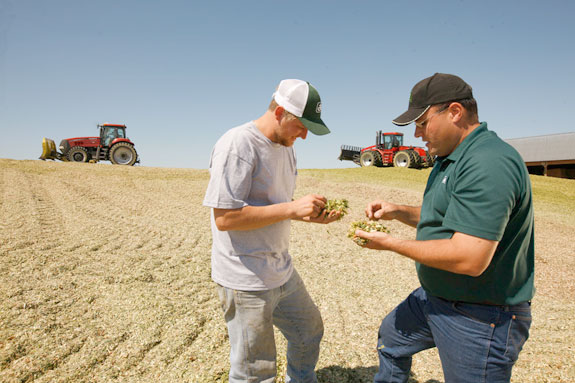To ensure corn silage is of the best quality possible, many factors and management decisions come into play – hybrid selection, fertility management, growing season, weather and much more.
At harvest, several of the factors you can control include both kernel processing and inoculant choice.
Reasons for kernel processingResearch at Washington State University and the University of Idaho has shown kernel processing not only affects the kernels but also the fiber part of the plant.
In addition, research at the USDA Forage Research Center supports that mechanical processing can improve feed efficiency and milk production.
This is because processing the kernels – whether via scratching, rolling or recutting – increases the exposed surface area of the kernel, resulting in improved digestibility.
Processed corn silage usually has increased NEL (net energy for lactation) values over non-processed silage due to corn-grain rolling making starch more available in the rumen.
Processed corn silage has been shown to have benefits in addition to milk production. Studies show that steers and heifers receiving processed corn silage have greater daily weight gains and were more efficient than those fed unprocessed corn silage.
Research also shows that kernel processing can increase the digestibility of the corn stover fiber. When processing breaks the ear into smaller particles, it reduces ration sorting and increases intake of this fiber source. These findings have spurred many producers to process their corn silage.
Kernel processing can be accomplished in many ways:
• through mechanical silage processors installed on the field chopper or at the storage site, where corn silage may be rolled as it is unloaded for feeding
• in the field by a processor mounted on a self-propelled or pull-type forage harvester
• at the silo during filling by a processor mounted on the blower or during unloading with a roller mill
Monitoring degree of kernel processing
Regardless of the processing method, the goal is the same: to minimize whole kernels present in the silage. That’s when the degree of processing becomes an area of focus.
The use of on-chopper roller mills to process corn silage affects the variation of the rate and extent of corn silage starch digestion.
To simply say silage was processed is not enough. What is needed is information on the roller mill setting (e.g., typically 1 to 5 mm depending upon kernel maturity) and objective quantification of the extent of subsequent kernel damage.
A standard degree of kernel processing laboratory procedure is commercially available at Dairyland, Dairy-1 and Cumberland Valley Laboratories to help quantify the degree of kernel damage.
 However, because this analysis is not a field test, producers still need to discuss processing goals with their nutritionist and custom cutter (if outsourcing chopping) to develop their own system (bunker or silo-side) for monitoring the number of undamaged kernels in a given volume of silage.
However, because this analysis is not a field test, producers still need to discuss processing goals with their nutritionist and custom cutter (if outsourcing chopping) to develop their own system (bunker or silo-side) for monitoring the number of undamaged kernels in a given volume of silage.
It is important to monitor each chopper several times a day to ensure processing consistency across fields and hybrids.
Considering harder kernels
Some newer, high-yielding corn varieties have genetically harder kernels.
This has led to concerns about the texture or vitreousness of corn kernels in silage.
The concern is that a harder corn kernel is more difficult for the cow to digest and may pass through the gastrointestinal tract undigested.
The most recent work on vitreousness from the University of Wisconsin supports that silage harvested wetter than about 35 percent DM exhibits very little difference in starch digestibility attributable to kernel texture or vitreousness. Specifically, ruminal starch availability showed a decline only after the black layer stage of maturity.
In addition, Ohio State researchers discovered that the level of kernel vitreousness has little, if any, impact on the digestibility of starch in fermented forms of corn such as silage or high-moisture grain.
This research found that total tract starch digestibility typically exceeds 96 percent for adequately fermented silage or high-moisture corn.
It is the microbial activity during fermentation and the chemical action of various fermentation end products that alter kernel storage proteins and remove most of the negative effects of zeins (prolamins) on starch digestibility.
In fact, for corn fed as fermented corn silage or high-moisture corn, more vitreous hybrids with large kernels actually appear to be preferable.
The reason? They typically have higher grain yields and the process of fermentation will minimize most of the adverse effects of vitreousness.
Overall, pre-ensiled processing of corn silage has been shown to offer several other benefits beyond digestibility and increased milk production.
These include: faster rate of silage fermentation, more densely packed material in the silo, decreased dry matter loss in silage storage and increased effectiveness of inoculants.
Inoculants choice critical
The right inoculant choices are critical to success today and will affect your operation for the entire feeding season. The basic role of an inoculant is to provide fast, more efficient fermentation of silage.
Fast fermentation not only preserves silage but also helps livestock producers maintain a high level of quality.
Some inoculants also offer aerobic stability. Packing removes oxygen, which is the fuel molds and bacteria use to grow and consume silage nutrients.
At feedout, the face of the silage bunker is exposed to oxygen. This starts the fermentation process all over. Some inoculants contain Lactobacillus buchneri, a bacterium that keeps the silo face cool, slowing secondary fermentation.
Keeping silage stable in the bunk and maintaining aerobic stability on the back end can add up to improved palatability and feed consumption.
In addition, some inoculants produce an enzyme that helps break down fiber in the silage, making it more digestible. The enzyme breaks down the lignin in the stalk, helping cows digest and use more of the available nutrients.
By getting more from your silage, you can rely less on supplemental feed, resulting in cost savings.
Inoculants also help limit the loss of important nutrients from the diet. By preserving these high-energy nutrients, you can increase the bite-for-bite value of your haylage, corn silage, snaplage, high-moisture corn and other grains.
As inoculants become more sophisticated in their ability to manipulate fermentation and digestibility, it will be possible to make forages higher in nutritional value than the day they were harvested, much like kernel processing improves corn silage nutritional value.
Cutting-edge inoculant products probably should be viewed as more of a management tool to improve nutritive value rather than as an insurance policy to reduce potential losses.
Overall, dairy producers constantly are looking for ways to improve forage yield and nutritional quality. By focusing on kernel processing as well as inoculation now, producers can positively impact the dairy herd through nutrient-rich silage for the next year. FG
PHOTOS
TOP RIGHT: Processing increases the exposed surface area of the kernel, resulting in improved digestibility.
BOTTOM RIGHT: Monitor several times a day to ensure processing consistency across fields and hybrids. Photos courtesy of DuPont Pioneer.











